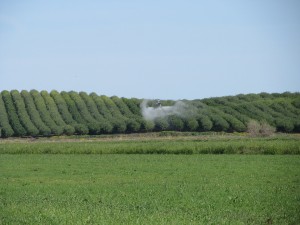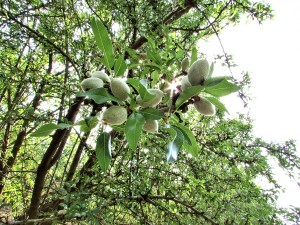
Director, Member Relations
This report covers conditions and observations made between Monday, March 7 and Sunday, March 20, 2016.
Northern Region –
Wet conditions dominated much of the final weeks of winter in the Sacramento Valley. Storms swept across the region in the period’s first week, then returned on the final day, dropping from 1.5 to as much as 4.0 inches of rain in the wettest locations. Daily temperatures were heavily influenced by the storms. Maximum readings were widely reported in the mid 50’s to lower 60’s during the period’s wetter, first week, then rose steadily into the upper 70’s under clearer skies during the final week of winter. Morning lows ranged predominately between the mid 40’s and lower 50’s, with readings dipping briefly into the upper 30’s on the morning of March 8th. Winds provided a bit of concern for growers during the period, with speeds approaching 20 mph during the mid-month storms and as high as 30 mph during the stormy final day of the period.
While the Sacramento Valley has experienced stormier conditions than the San Joaquin, observers are reporting that nevertheless, the crop in the northern region is progressing rapidly. Nuts are growing aggressively under the influence of the warmer temperatures. Meanwhile, unpollinated flowers have been dropping from the trees, along with dried jackets as the growing nuts increase in size.
Growers have ensured that their orchards were adequately protected against fungal infection, completing fungicide applications prior to the storms arrival or as soon as skies cleared. Fortunately, cold temperatures have not been a threat this year, which has precluded the need for frost protection irrigations. This has allowed most growers to complete applications using ground sprayers, while others have resorted to aerial applications in the interest of time or where the rain has made the use of machinery impossible. Where possible, mowers have also been sent into the orchards to reduce weed growth and growers have been working to complete fertilizer applications needed to support the developing crop.
Central Region –
Daily maximum temperatures have been on an upward trend during the final weeks of the winter season. Readings, which were widely reported in the low to mid 50’s as the period began, steadily climbed into the mid and upper 70’s, pausing briefly as a storm system passed over the state between the 11th and 14th of the month. Total rainfall for the period, received at mid-month and in the first day of the period reached as much as 2.75 inches. Morning minimum temperatures followed a more stable pattern, with readings on most mornings reported in the 40’s, with a few brief excursions into the lower 50’s and upper 30’s. The stormiest days of the period also brought brisk winds to the region with speeds in excess of 20 mph reported. While this did provide some degree of concern, trees losses were minimal.
The comparatively warm temperatures the region has experienced have provided for strong growth rates in the northern San Joaquin Valley. Nuts of all varieties are developing aggressively and have nearly all shed their jackets to the ground. The brisk winds that accompanied the recent storms have helped to scrub dried jackets from the trees, reducing the opportunity for fungal infection that was increased by the rain. While the winds have helped to clean the trees of unpollinated flowers, growers have noted that the winds also brought a number of viable nuts to the ground, as well.
Growers spent much of the period working to support the developing crop. Fungicide and fertilizer applications were going on in all areas of the region. While there has yet to be a serious threat of frost, growers remain vigilant and have been mowing excessive vegetation in order to maintain safe morning temperature levels within the orchards. Growers and Pest Control Advisors are monitoring orchards for signs of Oblique Banded Leaf Rollers and Leaf-Footed Plant Bugs, insect pests that can cause significant losses through their feeding on the developing nuts. While the threat of Leaf Roller damage will diminish in the weeks ahead, the threat of damage caused by Leaf-Footed Plant Bugs will continue until the almond’s shells harden.
Throughout the region, crews could be found installing irrigation systems in newly planted orchards, while beekeepers continue the task of removing their hives from the orchards.
Southern Region –
The final weeks of winter brought brief rainfall and rising temperatures to the southern region. Rain swept over the region on the first day of the period and returned on the 11th through the 14th. While the rainfall missed most of the region, wettest locations in Madera and Fresno Counties received as much as 1.5 inches of precipitation. Temperatures exhibited an upward trend during the period, pausing only briefly during the mid-month storms. Readings briskly climbed from the mid 50’s at the start of the period, reaching as high as 80 degrees with only a brief pause as the mid-month storms passed over the valley. Meanwhile, morning minimum readings remained steadily in the 40’s, with only brief forays into the upper 30’s on the coldest mornings.
The crop in the southern San Joaquin continues to develop aggressively, driven ahead by the warm temperatures that have dominated through the bloom and post bloom period. Observers have reported that the nuts in all varieties have broken free of their jackets and are growing rapidly. Many have noted that the growth rates have produced nuts that are much larger than would be expected for the date. Growers have noted a higher proportion of nuts shedding in recent weeks, no doubt increased by the winds that accompanied the mid-month storms. Wind speeds from 10 to 20 mph were reported, which has helped to scrub spent jackets and unpollinated nuts from the trees.
Growers are working to support the developing crop. Fertilizer applications have been going on throughout the region and growers with privately owned wells have begun irrigations. As may be seen in the accompanying photo, growers continue to work on their wells in order to provide water to the crop. Growers are also mowing weed growth within their orchards and monitoring the crop for signs of the Leaf-Footed Plant Bug, which can kill nuts through their feeding.


